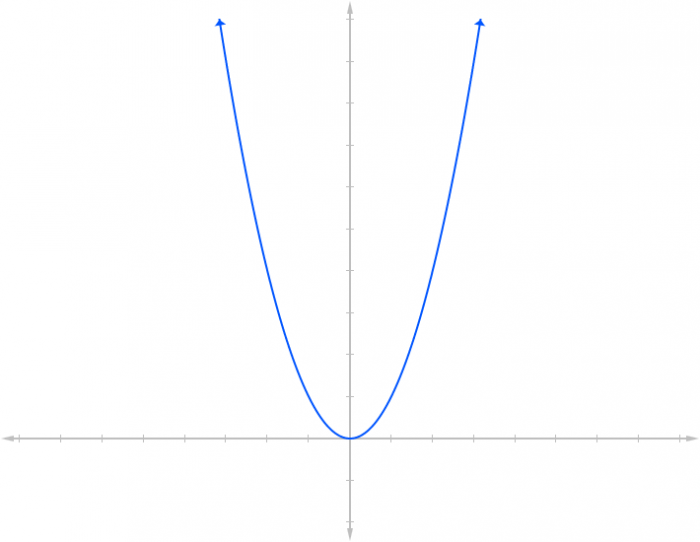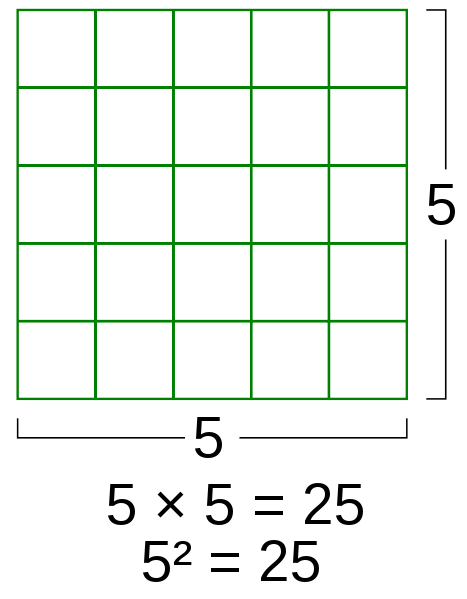
In math, the squared symbol (2) is an arithmetic operator that signifies multiplying a number by itself. The “square” of a number is the product of the number and itself. Multiplying a number by itself is called “squaring” the number. Squaring a number is a more specific instance of the general exponentiation operation, exponentiation when the exponent is 2. Squaring a number is the same as raising that number to the power of two. The square function (ƒ(x)=x2) is the inverse of the square root function (ƒ(x)=√x).
Raising a number n to the power of 2 is called “squaring” because the resulting number n2 corresponds to the area of a square with sides of length n. The square function is an extremely useful function in algebra, trigonometry, and physics. In algebra, the square function forms the backbone of some simplest kinds of polynomials (quadratics). In trigonometry, the square function is used to find the corresponding angles and side lengths of congruent triangles, a useful concept for modeling periodic phenomena. In physics, the square function can be used to compute distances between two points (in the form of the Pythagorean theorem) and modeled phenomena often takes the mathematical form of a square function, particularly equations involving velocity and acceleration.
Squaring: The Basics
Squaring a number is simple: Just multiply the number by itself: The symbol 32 just means 3×3. In general, for any number n:
n2 = n × n
Further, the square function has the interesting property that putting in the additive inverse of n will give you the same number: that is:
n2 = (−n)2
Strictly speaking, every positive number is the square of exactly two number, a positive and a negative number. 4 is the square of both 2 and −2. A number that is the square of an integer is called a perfect square. In general, the further down the number line one goes, the further and further spread out the distribution of perfects squares. This trend is because the square function grows exponentially; i.e. its rate of growth is proportional to its current value.
The inverse of the square function is the square root function ƒ(x) = √x. The square root of a number n is any a such that a2 = n. Because both a number and its additive inverse square to get the same result, every positive real number has exactly 2 roots +√x and −√x, sometimes expressed as ±√x. In most context, “the square root” of a number refers just to its positive root. The particular definition of the square root function makes it so that no negative real number has a square root, as no number multiplied by itself will produce a negative number. Negative numbers have square roots in the complex number system, but not in the real number system.
A graph of the function x2 looks like:

Credit: graphfree.com
Notice how the graph is perfectly mirrored along the vertical y-axis. The shape of the graph corresponds to the fact that every positive real number is the square of both a positive and negative number (except zero). As such, it is possible that a function in the general form of the square function will not have any roots—there is no n such that ƒ(n) = 0. Visually, this means that some square functions will never cross the x-axis.
Use Of The Square Function
Algebra
The square function forms the backbone of a special class of polynomial equations called quadratic equations. A quadratic polynomial of degree 2: that is, any polynomial in the form:
ax2 + bx + c
Where a, b, and c are all real numbers and a≠0. the terms a, b, and c are called the quadratic, linear, and constant coefficient, respectively. Quadratic equations can be factored to find their roots—values of x for which the entire equation equals 0. Alternatively, one can use the quadratic equation to solve for the roots of a quadratic polynomial:

Quadratic equation are useful for modeling motion, as the curve of accelerated motion takes the form of a square curve. If some motion has a constant rate of acceleration, then a graph of its motion will be a quadratic equation. The geometric shape of the quadratic function is called a parabola.
Geometry
The square function has many uses in geometry. Most obviously, the square function can be used to find the area of squares. It is a commonly known fact that the area of a square with sides of length n is equal to n2. This follows from the equation for the area of a rectangle (and parallelograms more generally) where A = l×w. A square is simply a rectangle where the length and the width are the same. The fact that the area of a square is a square function explains a property about the growth of square area: the area square whose length is n times longer has n2 more area.

The area of a square with lengths 5. Credit: WikiCommons CC0 1.0
Squaring also is used to find distances between two points in the context of the Pythagorean theorem. The Pythagorean theorem tells that the square of the sides of a right triangle (a triangle with a 90° angle) are equal to the square of the hypotenuse (a2+b2=c2). This formula can be used to compute the distance between the origin point of a coordinate-axis (0, 0) and any arbitrary point (x, y). One can draw a line extending from the origin point x units horizontally, then a line extending from that point y units vertically. The drawn shape will be a right triangle, and the distance between the origin (0, 0) and point (x, y) can be calculated as the hypotenuse of a right triangle with side lengths x and y.
The Pythagorean theorem is a special case of the more general parallelogram law that relates the length of the sides of a parallelogram to its diagonals: the parallelogram law states that the sum of the square of the lengths of the lengths of the four sides is equal to the sum of the square of the diagonals. Say we have a parallelogram with sides AB, BC, CD, and DA and diagonals AC and BD. The parallelogram law tells us that:
AB2+BC2+CD2+DA2 = AC2+BD2
Since in a parallelogram, opposite sides are, by definition, equal in lengths this equation can just be rewritten as:
2(AB)2+2(CD)2 = AC2+BD2
The Pythagorean theorem falls out of this equation in the case of a rectangle, where the diagonals are equal lengths.
Trigonometry
Squaring also pops up in laws relating the lengths of the sides of a triangle to its angles, in the form of the law of cosines. Simply put, the law of cosines states that for a triangle with lengths a, b, and c and opposing angles A, B, and C:
c2= a² + b² – 2ab×cos(C)
The cosine law can be rewritten to solve for each variable giving an equation with the exact same form, so the same equation will work for any side. The law of cosines allows you to determine the other components of a triangle if you know the length of at least two sides and one angle. The equation also simplifies to give the Pythagorean theorem in the case of right triangles. In the case of right triangles, ∠C = 90, so cos(C) = 0. The rightmost part of the equation cancels out, and we are left with c2= a² + b²
In Physics
In physics, the square function often rears its head in the context of equations the describe the intensity of some physical quantity as a function of distance. Due to the 3-D geometry of space, the intensity of any physical quantity that radiates outward in a sphere around the source is inversely proportional to the square of the distance from the source. This fact follows from the geometric law that the surface area of a sphere (4πr2) is directly proportional to the radius squared (r2) of the sphere.
For example, the force of gravity is an inverse square force as the strength of the gravitational attraction between two bodies is directly proportional to the mass of those bodies and inversely proportional to the square of the distance between those bodies. This is evident in the mathematical form of Newton’s law of gravitation
Fg= G(m1×m2)/d2
where m1 and m2 are the masses of the bodies and d is the distance between their centers of gravity. Incidentally, the force of electrostatic attraction between two bodies also takes the form of an inverse square law, as well as the measured intensity of light as measured from a point source.
The square notation is also used to define units of measurement in physics. For example, acceleration, the rate of change of velocity, is measured in the unit m/s2. This can be read “meters per second per second.” If velocity is the change in distance with respect to time, then acceleration is the change in velocity with respect to time. Acceleration is a measure of how much velocity is changing at each point of motion. If my acceleration is 6 m/s2, this means that my velocity (m/s) is increasing by 6 for every second of motion, hence meters per second per second.








